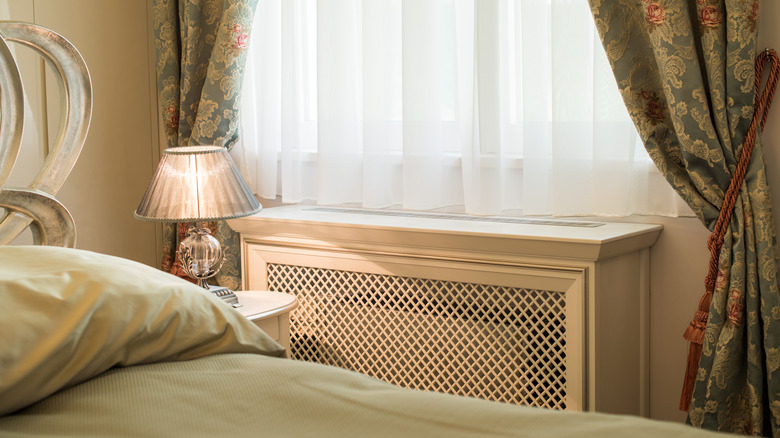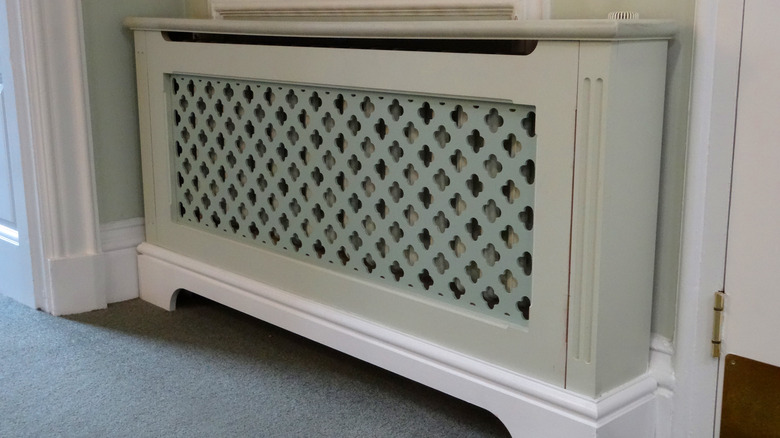TikTok's Beginner Woodworking DIY Radiator Cover Adds Style To Your Space
Older homes and apartments can sometimes contain lots of charming and fun features, including hardwood floors, crown molding, stained glass windows, and clawfoot bathtubs. Unfortunately, some aspects of older homes aren't so charming; for instance, clunky, immovable, paint-encrusted radiators stuck under otherwise perfectly good windows. Radiators have been a reliable means of heating homes since the mid-1800s, but their functional appearance hasn't changed much in the last two centuries. If you live in an older home with an unsightly radiator that's ruining your perfect aesthetic, consider building one of the easiest radiator makeovers that will upgrade your space – a radiator cover.
A radiator cover is essentially a breathable three-sided box that pops over your radiator and provides a more seamless appearance. With vintage and cozy homes looking all the rage lately, it makes sense that this clever DIY idea would pick up some traction on TikTok and other social media platforms. Here's how to build a simple, affordable, and stylish radiator cover inspired by TikTok's viral videos.
Building your DIY radiator cover
To make your radiator cover, you'll need enough wood to build a box large enough so that the wood never touches the appliance itself. Start by measuring your radiator's height, width, and depth all the way to the wall, then add at least 4 inches to each measurement to determine the length of wood you'll need for each side. You'll also need some very breathable, sturdy material for the front of the cover, such as woven cane webbing, a metal grate, or thin wooden slats. This DIY cover is a great opportunity to get creative with materials you already have; you can repurpose an old bed frame, or convert a cabinet or old entertainment console.
After cutting the wood and constructing the frame, attach your breathing material to the front of the cover. For a modern-looking cover, evenly spaced wooden slats look great, while metal grate material or cane webbing creates a more vintage, organic appeal. For a fancier-looking cover, add cove molding or trim around the breathable panels before painting or staining the wood. You can also add slats, drill holes, or attach a screen on the top and sides for improved ventilation. Cut a notch near the rear base of the frame so it can pop over any floor molding, then use brackets if needed to help it sit flush against the wall.
Is this TikTok design trend safe?
Some people may worry about the potential safety hazard of a wood radiator cover, but steam radiators shouldn't create a fire concern if proper safety precautions are taken. Steam radiators can reach just over 212 degrees Fahrenheit – enough to generate steam. Wood will usually catch on fire only when temperatures reach above 400 degrees Fahrenheit. Prolonged exposure can bring the flashpoint of wood down to 200 degrees, but a 2-inch clearance is usually enough to avoid this — hence why chimneys require a 2-inch clearance from wood beams in the attic. With a 4-inch clearing and temperatures usually below 212, your wood radiator cover should be fine.
While the cover should be safe with a functional radiator, it will be even safer on a retired or rarely used radiator. If you want to turn on the radiator with the cover still over the top, use a low heat setting to further reduce the risk of fire. You can also design the cover to be easily removable for when you want to crank up the heat and allow the room to warm up quickly. Either way, it's important to build the frame with ample ventilation to avoid overheating or moisture buildup inside the cover. As always, avoid placing fabric, paper, curtains, or any other flammable materials on or near the radiator.

